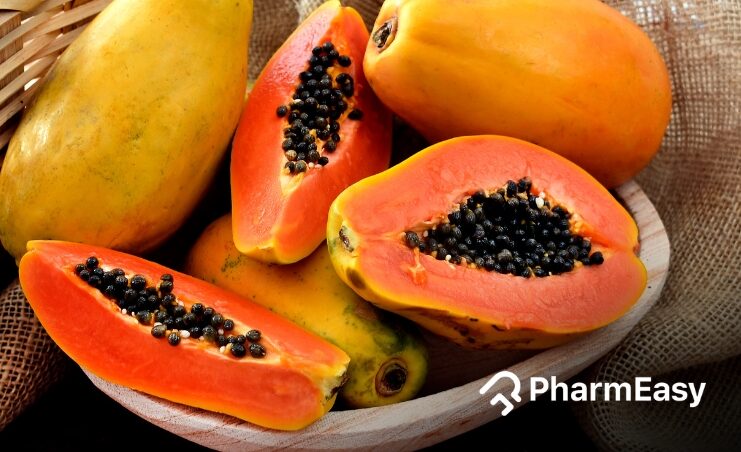Is Papaya Good for Diabetes? Evaluating the Research-Based Evidence
By Dr Rajeev Singh +2 more

Get more insightful and
helpful tips to
treat Diabetes for FREE



Download PharmEasy App




Register to Avail the Offer
Send OTPBy continuing, you agree with our Privacy Policy and Terms and Conditions
By Dr Rajeev Singh +2 more
Table of Contents
Diabetes is a global problem, impacting millions. Blood glucose levels are a key focus area in diabetes management. Medication, lifestyle changes, and a healthy diet are part of this effort. Several fruits and vegetables are said to play a useful role in diabetes diet and papaya is one of the. Deemed a superfruit, papaya is known for its rich nutrients and antioxidants. It has piqued interest in its potential benefits for those with diabetes. In this blog, we will look at the nutrient profile of papaya, and its influence on blood sugar levels. We’ll discover what health benefits it may offer to those with diabetes and how one might add it into a balanced, diabetes-friendly diet.
For a solid understanding of the effects of papaya on diabetes, we should first look at what’s in it. It’s:

Knowing the glycemic index of a food can clear the picture of its possible effect on blood sugar levels for people with diabetes.
Even though low GI fruits are usually fine for diabetics, high sugar intake can still harm blood sugar levels.
However, considering the sugar and carbohydrate content in papaya, when consumed in moderate amounts, it seems to be a suitable choice for those with diabetes.
So, let’s have a look at this table to see what all’s there in a papaya.
| Nutrient | Value (per small papaya) |
| Calories | 67 |
| Dietary fiber | 2.67 g (10% daily value) |
| Potassium | 286 mg (6.08% daily value) |
| Vitamin C | 95.6 mg (106.2% daily value) |
| Magnesium | 33 mg (8% daily value) |
| Calcium | 31 mg (3.1% daily value) |
| Sugar | 11 g (per 1 cup serving) |
| Glycemic index (GI) | 60 (medium GI range) |
Did you know?
Papaya is rich in health-protecting antioxidants like vitamin C, flavonoids, and carotenoids.
These compounds might help reduce inflammation and improve blood sugar control in diabetics. But more human studies are needed to confirm this benefit.
Some research suggests that papaya may help glucose enter liver and muscle cells
This could improve insulin sensitivity and hence, diabetes management, although further studies are needed to prove this.
3. Heart Health
Heart disease is a big concern for diabetics.
Papaya’s potential heart-protecting effect due its potassium and antioxidant content possibly make it beneficial as a part of diabetes diet. More research is needed to corroborate this benefit.
4. Digestive and Immune Health
Diabetes can disrupt digestive health, so immune support is crucial. Some research shows that
the fiber, vitamins, and antioxidants in papaya could help uphold a healthy digestive system and immune function.
If you’re more into lower GI fruits, think about these ones:
Other food options with similar benefits to papaya include:
Ad* You May Also Explore: Everherb Diabetic Care Juice
The potential perks of papaya for people with diabetes may be many, ranging from improved glucose uptake and insulin sensitivity to antioxidant and anti-inflammatory properties. Plus, it appears to support good digestive system health and immune function. However, more research is needed to prove these claims. Also, when including papaya in your meals, be sure to think about any allergies or sensitivities. Remember to always get advice from your healthcare professional. With due caution and useful advice from your healthcare team, papaya can be a tasty part of your diabetes control plan.
Papaya can potentially offer some health benefits for diabetics, but it’s key to keep an eye on your daily sugar and carbohydrate intake. Your healthcare provider may advise how often you can have papaya, based on your unique dietary needs.
Usually, low GI fruits, like apples, blueberries, and grapefruit, are safer options for diabetics. As tolerance levels can differ, it’s best to ask a healthcare provider to suggest the right fruits for you.
One cup of fresh papaya carries about 11 grams of sugar, and it has a medium GI rate of 60. When you’re eating papaya, it’s vital to keep your sugar and carbohydrate intake in check.
There isn’t a fixed “best” time to eat papaya. You can enjoy it anytime during the day as part of a healthy, balanced diet. However, always consider your specific sugar intake needs.
Disclaimer: The information provided here is for educational/awareness purposes only and is not intended to be a substitute for medical treatment by a healthcare professional and should not be relied upon to diagnose or treat any medical condition. The reader should consult a registered medical practitioner to determine the appropriateness of the information and before consuming any medication. PharmEasy does not provide any guarantee or warranty (express or implied) regarding the accuracy, adequacy, completeness, legality, reliability or usefulness of the information; and disclaims any liability arising thereof.
Links and product recommendations in the information provided here are advertisements of third-party products available on the website. PharmEasy does not make any representation on the accuracy or suitability of such products/services. Advertisements do not influence the editorial decisions or content. The information in this blog is subject to change without notice. The authors and administrators reserve the right to modify, add, or remove content without notification. It is your responsibility to review this disclaimer regularly for any changes.
Comments